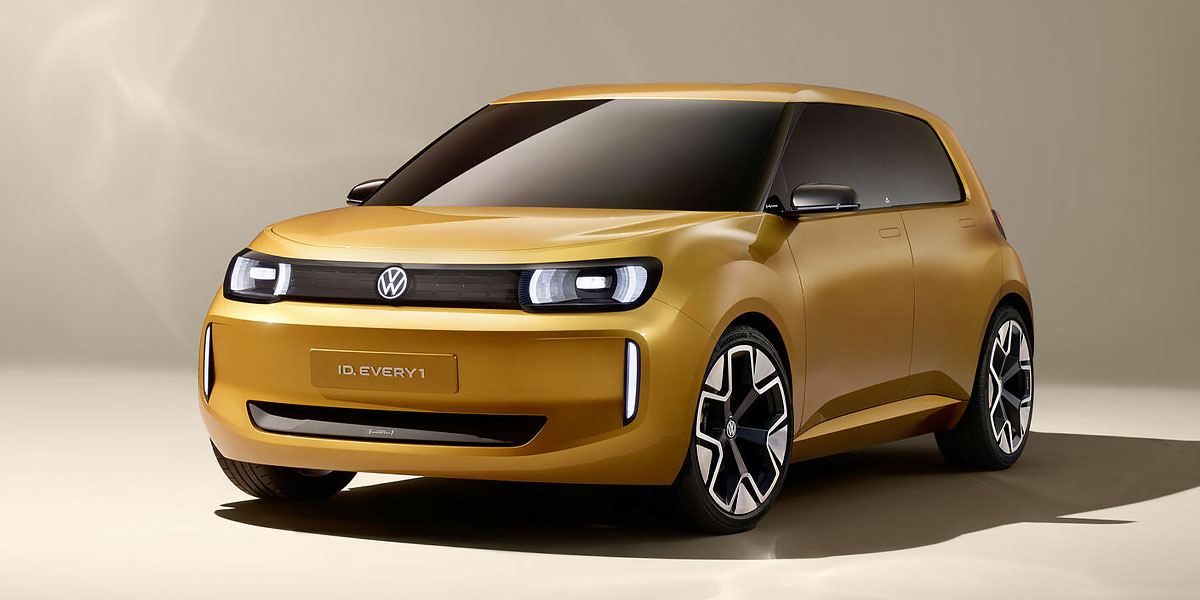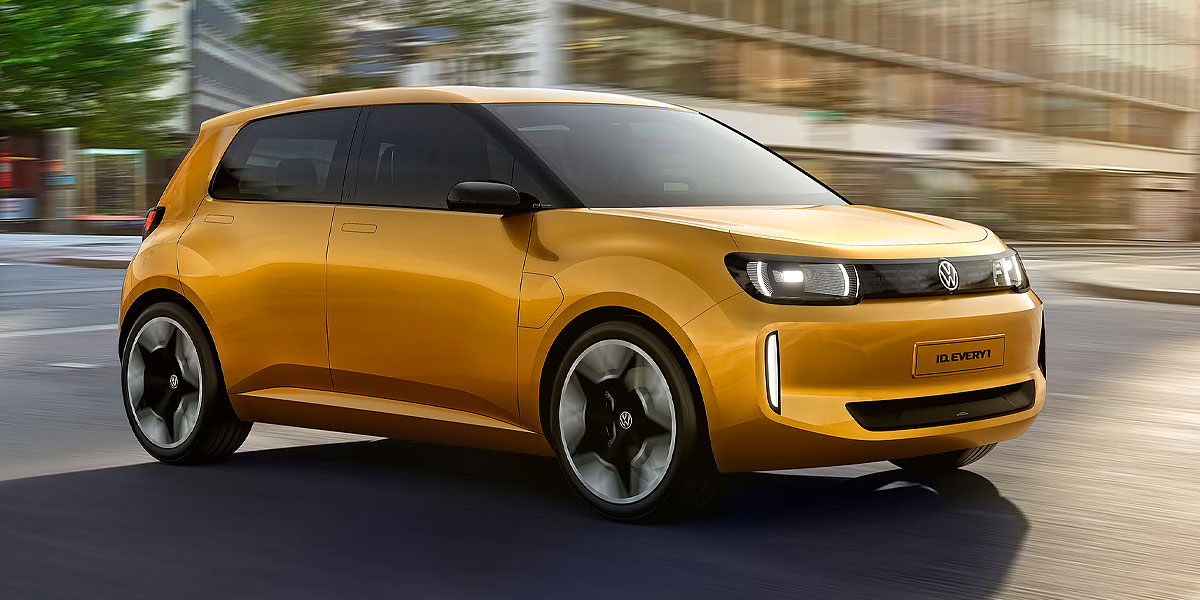Volkswagen ID EVERY1
User Rating: 3.80 / 5





What is the Volkswagen ID EVERY1?
The Volkswagen ID EVERY1 is a compact electric hatchback launching in 2027 at $21,500 (€19,995). Built in France, it offers 250 km (155 mi) of range, a 38 kWh battery, and a 95 hp front-wheel-drive system—designed to make EVs accessible for everyone.
Volkswagen ID EVERY1 price:
US$ 21500 *
| manufactured in | France |
| model year | 2027 |
| electric range (km) | 250 |
| battery (kWh) | 38 |
| max. speed (km/h) | 130 |
| power (h.p.) | 95 |
| car type | hatchback / 5 doors |
| drive type | FWD |
* Minimum price set by the manufacturer, excluding taxes and additional options

Exterior and Interior photos of Volkswagen ID EVERY1
Volkswagen ID EVERY1 Review
ID EVERY1 by Volkswagen: The Budget-Friendly Urban EV Europe’s Been Waiting For
Volkswagen’s new ID EVERY1 brings affordable electric driving back to the people. Manufactured in France and rolling out in 2027, this compact five-door hatchback is the spiritual heir to the Up! and the electric cousin of the classic Beetle. With a projected base price of just $21,500 (€19,995), the ID EVERY1 is gunning for the wallets of budget-conscious city drivers across Europe.
- Manufactured in France and scheduled for release in 2027, the ID EVERY1 marks VW’s return to small, affordable motoring—only now, it’s electric.
- Priced around $21,500 (€19,995), it undercuts much of the competition from Dacia, BYD, and Citroën.
- Built on the MEB Entry platform, it targets buyers who want European quality without the premium markup.
ID EVERY1 specs: Compact Size, Smart Performance
Battery
The ID EVERY1 is juiced by a 38 kWh lithium iron phosphate (LFP) battery—an economical, heat-resistant chemistry that trades ultimate range for durability and cost-effectiveness. You’re looking at a respectable 250 km (155 miles) on the WLTP cycle, which translates to about 130 miles in real-world driving. That’s more than enough for zipping around town or making weekend escapes.
- Battery capacity: 38 kWh
- Range: 250 km (155 mi)
- Battery type: LFP
Performance
Powering the front wheels is a modest 70 kW (95 hp) motor. While it won’t give Teslas a scare, it’s more than adequate for daily commutes, roundabouts, and navigating tight city streets. The ID EVERY1 tops out at 130 km/h (81 mph), with enough zip to hold its own in urban and suburban traffic.
- Power: 95 hp (71 kW)
- Top Speed: 130 km/h (81 mph)
- Drive Type: FWD
Though acceleration numbers aren’t disclosed, expect something in the 10-13 second range to 100 km/h (62 mph)—nothing heroic, but totally serviceable for its mission profile.
Exterior and Interior: Retro Vibes Meet Modern Utility
Exterior
The exterior leans heavy on charm. With chunky proportions and flared arches, it channels confidence without getting flashy. Its flat nose, animated LED lights, and smiling tail evoke Disney-esque friendliness. Volkswagen even slipped in nods to classics like the Golf Mk1 and the original Beetle—nostalgia with a plug.
Interior
Inside, things get clever. You’ve got physical buttons for volume, heat, and other essentials—finally. There’s a removable Bluetooth speaker between the seats, a sliding center console, and a modular dash with customizable inserts. Upholstery uses recycled materials and terrazzo-like finishes for a lounge-y, IKEA-meets-Volkswagen feel.
Pros and Cons
Pros
- Extremely affordable at $21,500 (€19,995)
- Friendly, compact design for tight cities
- Spacious for its size with 305 L trunk
- Physical buttons fix earlier VW complaints
- Modular, tech-forward interior
Cons
- Modest range for long hauls
- Only a four-seater
- Concept features may not carry over
- No U.S. release expected
Conclusion: Small Car, Big Intentions
The Volkswagen ID EVERY1 isn’t here to dominate drag strips or steal Model 3 customers—it’s here to get the EV doubters onboard. At under $22,000 (€20,000), it’s a nimble, approachable city runabout that gives everyday folks a way into electric mobility without taking out a second mortgage. And honestly? That’s a win worth watching.
Manufacturer: Volkswagen
Related Video
Comparison:
Stacking the Volkswagen ID EVERY1 against Europe’s other budget-friendly electric hatchbacks paints a clear picture: this is Volkswagen swinging back at the rise of affordable EVs from China and Renault. Going head-to-head with the Dacia Spring, Citroën e-C3, BYD Dolphin, and Renault 5 E-Tech, the ID EVERY1 makes a bold case for being the best all-around pick for city-dwellers who don’t want to compromise on design, space, or brand trust.
Range
The Volkswagen ID EVERY1 delivers 250 km (155 mi) WLTP range via its 38 kWh LFP battery. That’s more than the Dacia Spring at 230 km (143 mi), but short of the BYD Dolphin at 427 km (265 mi). The Citroën e-C3 also promises a competitive 300 km (186 mi), while the Renault 5 E-Tech is aiming for about 400 km (249 mi). Still, for under $22,000 (€20,000), 250 km isn’t bad at all.
Acceleration
Volkswagen hasn’t published official 0–100 km/h numbers, but with 95 hp (71 kW), expect the ID EVERY1 to do it in roughly 11–13 seconds. The Dacia Spring takes around 13.7 seconds, while the Citroën e-C3 should clock in slightly faster. BYD Dolphin and Renault 5 E-Tech—with stronger motors—are expected to cut that time significantly, potentially under 10 seconds.
Power
At 95 hp (71 kW), the ID EVERY1 edges out the Dacia Spring (65 hp / 48 kW) and matches the lower-spec Citroën e-C3. The Renault 5 and BYD Dolphin offer variants with 120–204 hp (89–152 kW), so they naturally attract buyers looking for a little more bite with their commute.
Charging Time
The ID EVERY1’s exact charging speed isn’t confirmed, but with a smaller 38 kWh battery, even basic DC fast charging should refill it in under 30 minutes to 80%. Dacia Spring has modest DC charging, taking 45 minutes. Citroën e-C3 and Renault 5 E-Tech promise faster charging on 100 kW+ setups, while the BYD Dolphin supports high-speed charging but only on upper trims.
Price
Volkswagen aims to keep the ID EVERY1 at $21,500 (€19,995), making it one of the cheapest brand-name EVs in Europe. Dacia Spring starts lower at $20,000 (€18,000), but offers fewer features. The Citroën e-C3 is similar in price but with stronger range. Renault 5 E-Tech and BYD Dolphin start higher—closer to $25,000–$30,000 (€23,000–€28,000).
F.A.Q.:
What is the price of the ID EVERY1?
The Volkswagen ID EVERY1 is expected to start at $21,500, which is approximately €19,995 based on current exchange rates.
What is the range of the VW ID EVERY1?
The ID EVERY1 offers a range of up to 250 km (155 miles) on the WLTP cycle, suitable for daily city commuting and short trips.
What is the usable battery capacity of this EV?
The battery has a total capacity of 38 kWh, utilizing LFP chemistry for durability and cost efficiency.
How fast can the vehicle go?
The top speed of this electric hatchback is 130 km/h (81 mph), ideal for city and suburban travel.
What kind of power does it deliver?
The car delivers 95 horsepower (71 kW) from a front-mounted electric motor.
How long does the ID EVERY1 battery take to charge?
Exact charging times haven't been confirmed yet, but expect DC fast charging at moderate speeds given the smaller battery size.
What is the drive configuration?
The vehicle comes with front-wheel drive (FWD), optimizing space and keeping weight and cost low.
How spacious is the ID. EVERY1?
Despite its size, it offers a 305-liter (10.8 cu ft) trunk and a roomy interior thanks to the long wheelbase and MEB Entry platform.
What type of interior tech is available?
The interior includes a large central touchscreen, digital cockpit, physical buttons for key functions, and a modular center console.
Is the ID. EVERY1 good for highway driving?
While capable of short highway trips, its top speed and range make it best suited for urban and suburban driving environments.







